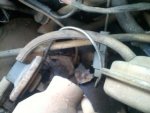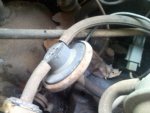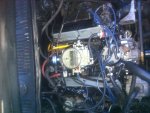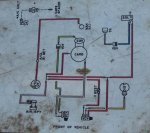yo NIGEL.
WELCOME!
For now until someone here can give you a pic or validated info;
Here is one Vacuum Line Routing Diagram in a 81 351W; Calibration 1-24P-R21
http://content.chiltonsonline.com/content/images/8576/images/85764154L.gif'>http://content.chiltonsonline.com/content/images/8576/images/85764154L.gif
by Chilton
See if you can find the calibration number
more diagrams:
Calibration 1-24R-RO
http://content.chiltonsonline.com/content/images/8576/images/85764156L.gif
Calibration 1-24P-R21
http://content.chiltonsonline.com/content/images/8576/images/85764154L.gif
Chilton Manual for 66-81 Bronco, Scanned Copy
Source: by Chilton via broncocity.com @
http://www.broncocity.com/66-81manual.htm
see Chapter 4 Emissions & Fuel System
page 144-145 describes the EGR Valve and a General diagram
mentions vacuum signal which operates the EGR valve originates at the EGR vacuum port in the carburetor. This signal is controlled by at least one, and sometimes two series of valves.
A water temp sensing valve (the EGR PVS) which is closed until the water temp reaches either 60 def F or 125 deg F depinding upon application, is always used.
acronyms (not nec. for your year/engine) complied from Seabronc, and others here.
A/CL: Located in the air cleaner
A/CL DV: Air Cleaner Diverter Valve
A/CL BI MET: Air Cleaner Bi-Metallic Valve
A/CL CWM: Air Cleaner Cold Weather Modulator
ACT: Air Charge Temperature Sensor, prior to 1992
ACTS: Air Cleaner Temperature Sensor
ACV: Air Control Valve
AIR: Thermactor, short for Thermal Reactor. CA vehicles are installed with it as standard. Air Injection Reaction is what it stands for.
AIR BPV: AIR BPV is the AIR Bypass (AIRB) Valve; also called the TAB (Thermactor Air Bypass) Valve
BV: Bowl Vent (on top of the float tanks)
CARB: Carburetor
CBD: Closed Bowl Distributor
CPRV: Canister Purge Valve
DIST: Distributor
DPFE: Differential Pressure Feedback
DV-TW:Two Way Delay Valve
EFCA: Electronic Fuel Control Assembly/ (Fuel Pressure Regulator (FPR)
EGR: Exhaust Gas Recirculation
EGRC/EGRV: EGR Vent/EGR Control
EXH HCV: Exhaust Heat Control Valve
EVP: EGR Valve Position
EGR: Valve Position
EVR: EGR Vacuum Regulator; also called EGR Vacuum Solenoid
FLTR: Filter
FPR: Fuel Pressure Regulator (check vacuum line)
HEAT VLV INT: Heat Vacuum Control Valve Intake, (next to carb)
HICV: Hot Idle Control Valve
IAT: Intake Air Temperature Sensor (Air Charge Temperature (ACT), prior to 1992
IVV: Thermactor Idle Vacuum Valve
LCV: EGR Load Control
MAN VAC: Manifold vacuum-Vacuum source; usually ref. to as Vacuum Tree atop intake manifold]
MAP: Manifold Absolute Pressure
PCV: Positive Crankcase Ventilation
PURGE: Vapor Canister Purge Valve
PV: Ported Vacuum
PVS: Ported Vacuum Switch (PVS) Valve
S: Spark port
SA-FV: Separator Assembly Fuel/Vacuum
SOLV: Thermactor Solenoid Valve
SV CBV: Carborator Fuel Bowl Solenoid Vent Valve
TCAC: Thermostatically Controlled Air Cleaner
TCP: Temperature Compensated Accelerator Pump
TK: Throttle Kicker
TVS: Throttle Valve Solenoid (aka Solepot, Dashpot)
or
TVS: Temperature Vacuum Switch
TVV: Thermal Vacuum Valve
or, TVV: Thermostatic Vacuum Valve (aka Ported Vacuum Switches; Thermal Vacuum Valve)
VAC: Vacuum
VCKV: Vacuum Check Valve
VCV: Vacuum Control Valve
VDV: Vacuum Delay Valve
V CK V or VCV: Vacuum Check Valve
VOTM: Vacuum Operated Throttle Modulator
VRDV: Distributor Vacuum Delay Valve (VDV, VRDV, DV-TW)
VRDV: Vacuum Delay Valve (VDV, VRDV, DV-TW)
VRESER: Vacuum Reservoir (coffee can style in earlier years; replaced by plastic style)
VRESV REST: on earlier years such as SEABRONC's 83 is a Vacuum Restictor/delay valve, it delays vacuum for a certain amount of time
VRV: Vacuum Regulator Valve
WOT: Wide Open Throttle Valve




